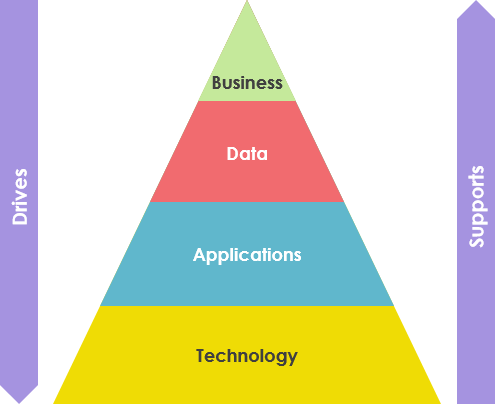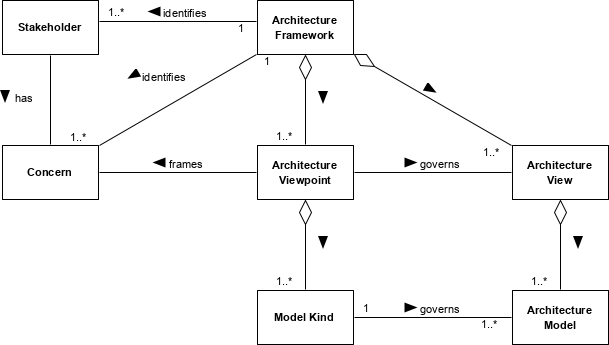What is Enterprise Architecture?
Layers of Enterprise Architecture
Enterprise architecture is unique to every organization, however, there are some common elements. Since Stephen Spewak’s Enterprise Architecture Planning (EAP) in 1993, and perhaps before then, it has been normal to divide enterprises architecture into four architecture domains.
The four commonly accepted domains of enterprise architecture are:
Business architecture domain – describes how the enterprise is organizationally structured and what functional capabilities are necessary to deliver the business vision. Business architecture addresses the questions WHAT and WHO: WHAT is the organization’s business vision, strategy, and objectives that guide creation of business services or capabilities? WHO is executing defined business services or capabilities?
Application architecture domain – describes the individual applications, their interactions, and their relationships to the core business processes of the organization. Application architecture addresses the question HOW: HOW are previously defined business services or capabilities implemented?
Data architecture domain – describes the structure of an organization’s logical and physical data assets and data management resources. Knowledge about your customers from data analytics lets you improve and continuously evolve business processes.
Technology architecture domain – describes the software and hardware needed to implement the business, data, and application services. Each of these domains have well-known artifacts, diagrams, and practices.

Business architecture domain – describes how the enterprise is organizationally structured and what functional capabilities are necessary to deliver the business vision. Business architecture addresses the questions WHAT and WHO:
- WHAT is the organization’s business vision, strategy, and objectives that guide the creation of business services or capabilities?
- WHO is executing defined business services or capabilities?
Application architecture domain – describes the individual applications, their interactions, and their relationships to the core business processes of the organization. Application architecture addresses the question HOW: HOW are previously defined business services or capabilities implemented?
Data architecture domain – describes the structure of an organization’s logical and physical data assets and data management resources. Knowledge about your customers from data analytics lets you improve and continuously evolve business processes.
Technology architecture domain – describes the software and hardware needed to implement the business, data, and application services. Each of these domains have well-known artifacts, diagrams, and practices.
For many years, it has been common to regard the architecture domains as layers, with the idea that each layer contains components that execute processes and offer services to the layer above. Many EA frameworks combine data and application domains into a single information system layer, sitting below the business and above the technology (the platform IT infrastructure).
Why Enterprise Architecture?
The scope of enterprise architecture includes: the people, business processes, information and technology of the enterprise, and their relationships to one another and to the external environment. Enterprise architecture applies architecture principles and practices to guide organizations through the alignment of these architecture domains: business, information, process, and technology. These involve utilize the various aspects of an enterprise to identify, motivate, and achieve these changes by performing:
- Business and technology alignment
- Consistency in a federated landscape
- Interoperability and information sharing
- Return on investment
- Flexibility and agility
What is an EA Framework?
An Architecture Framework establishes a common practice for creating, interpreting, analyzing and using architecture descriptions (Views and Viewpoints) within a particular domain of application or stakeholder community. It is a structure for the content of an Enterprise Architecture Description, according to the IEEE 1471 definition, we can describe an EA framework as the model shown below:

Utilizing an Enterprise Architecture framework streamlines the process for creating and maintaining architectures at all layers (e.g. enterprise architectures, functional business segment architectures, cross-cutting technology domain architectures, and solution architectures) and enables an organization to leverage the value of architecture best practices.
An Enterprise Architecture framework provides a collection of best practices, standards, tools, processes, and templates to assist in the creation of the Enterprise Architecture and architectures of various scopes. Enterprise Architecture frameworks typically include:
- Common vocabulary, models, and taxonomy
- Processes, principles, strategies, and tools
- Reference architectures and models
- Prescriptive guidance (EA processes, architecture content, implementation roadmap, governance)
- Catalog of architecture deliverables and artifacts
- Enterprise Architecture Content Meta-model















![Toni Kroos là ai? [ sự thật về tiểu sử đầy đủ Toni Kroos ]](https://evbn.org/wp-content/uploads/New-Project-6635-1671934592.jpg)


